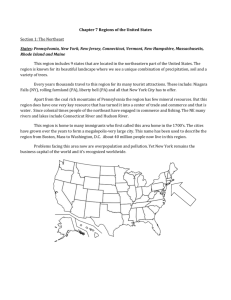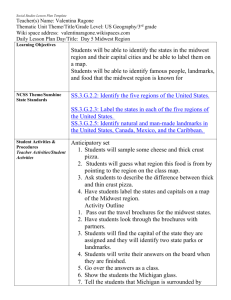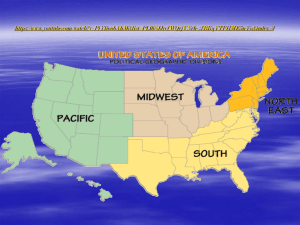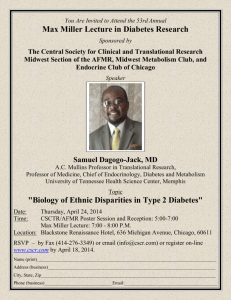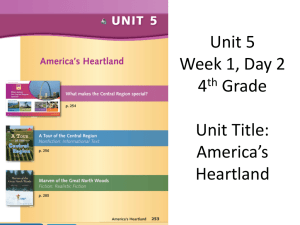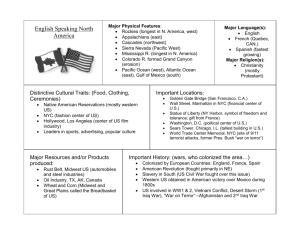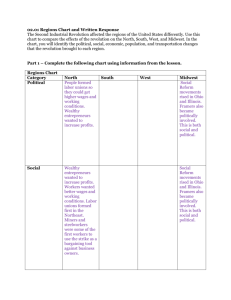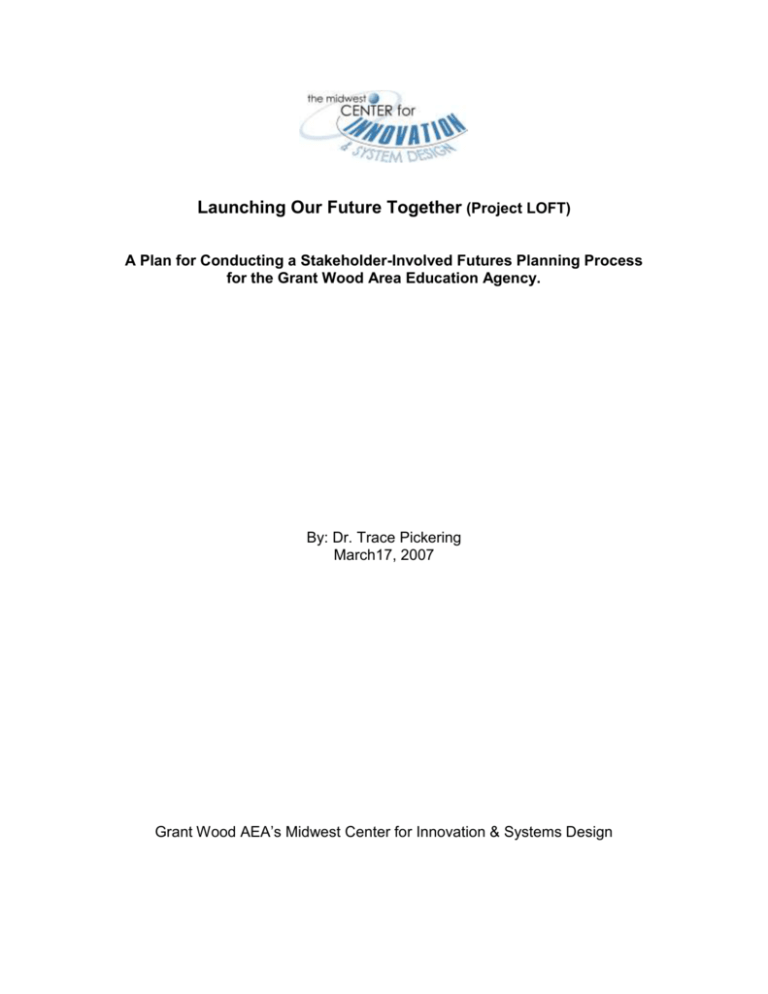
Launching Our Future Together (Project LOFT)
A Plan for Conducting a Stakeholder-Involved Futures Planning Process
for the Grant Wood Area Education Agency.
By: Dr. Trace Pickering
March17, 2007
Grant Wood AEA’s Midwest Center for Innovation & Systems Design
Table of Contents
THE HISTORY OF INNOVATION AT GRANT WOOD AEA ................................ 3
THE AGENCY’S CONTEXT ................................................................................. 6
INTRODUCTION TO SYSTEMS THINKING ........................................................ 7
Defining a System ......................................................................................................................................... 7
Mechanical, Biological, and Socio-Cultural Constructs ...........................................................................10
THE PROPOSAL FOR THE LAUNCHING OUR FUTURE TOGETHER
PROJECT ........................................................................................................... 17
Interactive Design and Strategic Planning ................................................................................................17
Key Assumptions .........................................................................................................................................19
The Design Process ......................................................................................................................................21
Stage I: Problem Formulation ...................................................................................................................21
Stage II: Gathering Stakeholder Design Specifications ............................................................................23
Stage III: Creating & Proposing Designs ..................................................................................................24
Stage IV: Developing the First Approximation of the New Design .........................................................25
Structure ......................................................................................................................................................26
The Design Team – Team Makeup ...........................................................................................................26
Design Team - Responsibilities ................................................................................................................27
Meeting Structure .....................................................................................................................................27
TIMELINE ........................................................................................................... 29
BIBLIOGRAPHY ................................................................................................ 33
The Midwest Center for Innovation & Systems Design, 2006-2007. All Rights Reserved.
2
The History of Innovation at Grant Wood AEA
Grant Wood Area Education Agency (the Agency) has a long history of
successful strategic planning and innovation in and around the region. The
Agency has participated in several rounds of strategic planning under the
leadership of Dr. Ron Fielder. Since 1987, the Agency regularly and consistently
has applied the current best-thinking planning tools and processes to engage in
strategic planning and design. Langdon Morris, author of Permanent Innovation,
identifies four distinct but critical types of innovation that organizations must
continually engage in to be viable in ever-changing environments: (a)
Incremental Innovation; (b) Breakthrough Product and Technology Innovation; (c)
Business Model Innovation, and; (d) New Venture Innovation (Morris, 2006). The
Agency has regularly engaged in such innovations over the past several
decades.
One of the most transformational rounds of Agency planning led to the
creation of a regionalized service delivery system that proved to be a significant
and important innovation in the way intermediate service agencies define their
markets and access those markets via distribution channels. This service
delivery model has experienced several years of continuous improvement as it
has worked to develop and meet the ever-changing demands an intermediate
service agency experiences. Morris identifies such innovation as a “new business
model innovation” in which organizations, “figure out how to deliver products or
new technologies in innovative ways that creates superior experiences for their
customers.” (Morris, 2006, p. 32).
The Midwest Center for Innovation & Systems Design, 2006-2007. All Rights Reserved.
3
The Agency is also recognized as a leader in the innovation of
breakthrough products and services. Under Fielder and long-time director, Dr.
Cliff Ehlinger, the Agency continually leads the state in innovative technology
solutions. From the design and delivery of a payroll management system for
education, to large-scale databases designed both internally and with
cooperation from private providers, the Agency has continually led the state in
technical and product innovation. Agency innovations and support has included
solutions that manage such things as: special education data, student
performance data, the generation of state-mandated reports, managing data
systems such as email, internet access and storage solutions, and solutions
assisting the Agency in being as efficient and effective as possible. Morris calls
such innovation, “breakthrough product and technology innovations.” (Morris,
2006, p. 30).
In 1994 the Agency, in cooperation with a local community college,
founded a non-profit center designed to provide leadership and support in the
newly emerging quality movement. Named the Woods Quality Center, it went on
to become a self-sustaining entity called the Iowa Quality Center and continues
as a viable enterprise providing valuable services and support in the quality
arena including training, support, and evaluation of processes such as Baldrige,
Lean, Six Sigma and others. In 2006, the Agency launched The Midwest Center
for Innovation & System Design in cooperation with leading social system
scientist Jamshid Gharajedaghi. The Center provides education, consulting, and
design services to help organizations redesign themselves to better manage and
The Midwest Center for Innovation & Systems Design, 2006-2007. All Rights Reserved.
4
adapt to the rapidly changing environments they now find themselves in. Such
innovative practice is coined “new venture innovation” by Morris and is distinct
from the others because, “the creation of a new venture is an organizational
response to innovation, a journey into new territory where new skills,
perspectives, and indeed an entirely new identity are required.” (Morris, 2006, p.
36).
Like virtually every organization, the Agency is constantly involved in
incremental innovations characterized most readily by continuous improvement
practices. The Agency continually works to improve processes, practices,
products, and services to improve both the efficiency and effectiveness of the
Agency.
The Agency has chosen to utilize its own innovative venture, The Midwest
Center for Innovation & System Design, in order to conduct this strategic
planning and futuring process. The methodology used by the Center, sociocultural systems design methodology, is rapidly gaining acceptance as a current
best-thinking approach. The Agency’s leaders – both formal and informal –
recognize that designing and delivering an effective educational system in
today’s context requires a methodology and set of assumptions quite distinct
from past mental models and assumptions – a set of assumptions that doesn’t
treat organizations and the people in them as parts of a machine or biological
organisms analogous to the human body. Today’s world demands that
organizations actively engage all its members in the development of the
organization and the individual members it comprises. Grant Wood Area
The Midwest Center for Innovation & Systems Design, 2006-2007. All Rights Reserved.
5
Education Agency stands poised and ready to enter into this new world of
organizational design and based on learning and knowledge from past planning
and innovation, will create and implement an innovative plan for the new context.
The Agency’s Context
Books such as The World is Flat, (Friedman, 2005) have helped America
to recognize more fully that the context of the world and how we interact with it
has changed in monumental ways. Technical advances are making the world a
smaller place by leveling the playing field for countries and nations previously
excluded from the global marketplace and economy. America’s long-standing
response to such external threats has been to threaten, cajole, blame, and/or
attempt to improve real or perceived inadequacies of its educational system. This
decade’s intense emphasis on schools has not been seen on this scale since the
1957 launch of Sputnik and, on a smaller scale, the publishing of The Nation at
Risk report in 1983 (National Commission on Excellence in Education, 1983;
Daggett, 2005; Finn, 2005; Fullan, 2003; Kohn, 1999; Sarason, 1990; Sarason,
1996).
While the Agency is significantly impacted by federal, state, and local
responses to the new demands on education, other contextual factors are
interacting to create a very new, complex, and chaotic environment for
intermediate service agencies and the Agency in particular. Rapidly changing
demographics in both Iowa and the nation impact the Agency’s funding, it’s ability
to attract and retain talent, it’s approaches to servicing client needs, and, in the
short-term, the results the Agency is able to achieve. A critical success factor for
The Midwest Center for Innovation & Systems Design, 2006-2007. All Rights Reserved.
6
organizations today, including the Agency, is knowledge work, not physical work
(Tarr, 2004, p. 1). Knowledge workers are commonly defined as working
primarily with information or who develops and uses knowledge in the workplace.
Such workers require different structures that are flexible and capable of rapid
adaptation and adjustment in order to be successful. While physical workfocused organizations relied on reductions in variation to ensure quality,
knowledge work-focused organizations must foster variation in order to ensure
innovation and high-quality. In addition, generational differences in the workforce
are stressing the Agency’s traditionally-designed mentoring, induction and
retention system. Finally, the Agency exists in a place that is often squeezed
between a traditional and an emerging set of paradigms. Many local school
systems – Agency clients – are recognizing the need to redesign their
organizations in new and innovative ways while legislated mandates often strive
to maintain the old functions, structures and processes that have, to-date,
defined what “school” means. The Agency works within and as a part of both
innovative local, state and national innovation and the more mechanicallyinclined world of legislative mandate and measurement.
Introduction to Systems Thinking
Defining a System
This introduction provides a basic view of three generations of systems
theory and suggests how traditional models, exemplars, and formulas for
transforming education fundamentally fail to approach problems from the third
generation systems perspective. The socio-cultural or Third Generation systems
The Midwest Center for Innovation & Systems Design, 2006-2007. All Rights Reserved.
7
paradigm refers to the current iteration of systems thinking that has evolved over
three generations and roughly fifty years: Operations Research to Cybernetics to
Idealized Design (Gharajedaghi, 2004, p.1).
To understand where traditional reform efforts fit and why they will most
likely fail, it is important to first clearly define a “system” and then to briefly frame
the three generations of system paradigms that exist in American thought today.
Taken together, they represent an evolution of thinking and acting that has a
profound influence on planning in both the problem definition and the solutions
created. Since Senge’s declaration that, “systems thinking is a conceptual
framework, a body of knowledge and tools” (Senge, 1990, p. 7) in his best seller
The Fifth Discipline in 1990, the word “systems” is used often by business people
and educators, quite often, with little real understanding of the term and its
possible implications. Since a car is a system, a horse is a system, and a school
district is a system, each with its own unique set of operating principles, it
provides little value or insight when someone demands that the system be
examined. A deeper set of questions remain: How do we classify and attempt to
explain differences in the systems we use and experience? Which type of system
are we attempting to describe? What is the best way in which to design and
deliver that system?
First, a clear definition of a system: [italics in original reference] “A system
is a set of two or more elements that satisfies the following three conditions:
1. The behavior of each element has an effect on the behavior of the
whole.
The Midwest Center for Innovation & Systems Design, 2006-2007. All Rights Reserved.
8
2. The behavior of the elements and their effects on the whole are
interdependent.
3. However subgroups of the elements are formed, each has an
effect on the behavior of the whole and none has an independent
effect on it” (Ackoff, 1999, p. 16).
Accepting this definition means that a system cannot be divided into its
independent parts. Doing so causes both the part to lose key properties and the
system to lose essential properties that none of the parts alone has or can
produce (Ackoff, 1999, p. 16). This is true for all three generations of system
thinking – mechanical, biological, and socio-cultural – although it is much easier
to see such interdependencies in mechanical and biological systems. In a
mechanical system like a car, removal of the fuel pump causes the pump to lose
its ability to function and the car to lose its essential property – the ability to
transport. In a biological system such as a human, removal of the eye causes the
eye to lose its ability to see and the person to lose their depth of field. In a social
system such as an orchestra, removal of the trumpet section causes the loss of
the individual qualities of the trumpet players and the balance and harmony of
the orchestra itself. By themselves, they are unable to create the complex and
beautiful music that they can produce together.
The Midwest Center for Innovation & Systems Design, 2006-2007. All Rights Reserved.
9
Mechanical, Biological, and Socio-Cultural Constructs
We see the world as increasingly more complex and
chaotic because we use inadequate concepts to
explain it. When we understand something, we no
longer see it as chaotic or complex.
(Gharajedaghi, 1999, p. 25).
The ways in which people and organizations attack system problems are
defined by these three distinct mental models: mechanical, biological, and sociocultural. Knowledge of these mental models also offers a glimpse into why
planning methods and approaches entrenched in the first and second-generation
systems thinking, mechanical and biological, cannot propel education from its
current state. To illustrate the distinctions between these mental models of
systems, a more complete explanation of each follows.
Despite much rhetoric to the contrary, the first generation of systems, the
mechanical view, is the prevalent mental model of system theory in America
today (Gharajedaghi, 1999, p. 10). America’s rise to power and prominence
came from the ability to translate this worldview into a commercial success. The
industrial age was defined by the belief that everything in the world would one
day be explained through science; that through careful analysis of smaller and
smaller parts, all the secrets of the universe could be unlocked. In essence,
mechanical thinking postulates that understanding is derived from taking a
system apart and examining each part, explaining how the parts behavior
The Midwest Center for Innovation & Systems Design, 2006-2007. All Rights Reserved.
10
separately, and then aggregating the understanding of the parts into an
explanation of the whole (Ackoff, 1999, p. 17). America utilized this mental model
of systems to create the greatest industrial nation in the world.
The basic assumption of the mechanical mental model is that by
optimizing and making each part function as efficiently as possible, the function
of the whole will be improved. The theory also assumes the parts operate in
highly defined, highly predictable ways thereby allowing the designer complete
control over the organization and its functions. Solutions to problems in this
framework result from careful analytical study – identifying the malfunctioning
part, applying a solution to that part to optimize the part’s performance and, it is
assumed, the system’s performance. Success in the mechanical mental model is
defined by efficiency and the ability of organizations to break down tasks to their
most simple in order to ensure mindless, predictable repetition (Ackoff, 1991,
1999; Ackoff & Rovin, 2003; Gharajedaghi, 1999). The following serve as
examples of this worldview: Ford’s assembly line, Taylor’s management
principles, and the Committee of Ten (1893) that designed the current functions
and structures of the American system of public education (Spady, 2001; Hock,
1999; Gharajedaghi, 2005b; Ackoff, 1999).
The second generation of systems, the biological mental model, emerged
in the United States in mid-twentieth century and described organizations as
living systems – analogous to the human body. The essential biological mental
model assumption posits that there must be a brain making decisions based
upon feedback from the parts – each of which has a clear and specific function.
The Midwest Center for Innovation & Systems Design, 2006-2007. All Rights Reserved.
11
Each part’s job is to function as effectively and efficiently as possible, providing
performance feedback to the brain in order that the brain may make decisions in
the best interest of the organization. This view modified the mechanical mental
model only incrementally. The only substantial distinction was the view that the
parts in an organization could provide valuable feedback. In this respect,
organizational theory moved from mindless to uni-minded. Like an organism, the
measure of organizational success was growth and it created a paternalistic
business culture – one in which people felt they had a job for life, the CEO was a
revered figure, and the organization strived to become bigger and bigger
(Gharajedaghi, 1999, p. 11).
This systems-view gave rise to the Alfred Sloan School of Management –
a divisional structure in which powerful leaders dictated and controlled the
various systems of the organization, seeking feedback as deemed appropriate
from the workers and divisional parts of the organization. This mental model also
created the concept of Operations Research as developed by Churchman and
Ackoff (Ackoff, 1999, pp. 316-318).
The third generation view, the socio-cultural mental model, is a
qualitatively different way of conceptualizing and explaining system behavior and
is one more adequately suited to working with human systems like schools.
Gharajedaghi defines a socio-cultural system as, “a voluntary association of
purposeful members who themselves manifest a choice of both ends and means”
(Gharajedaghi, 1999, p. 12). This view reverses the mechanical mental model in
several ways. The socio-cultural conception of a system:
The Midwest Center for Innovation & Systems Design, 2006-2007. All Rights Reserved.
12
1)
Treats systems of people as people and not mindless parts
capable only of rote repetition or feedback. People have minds
and they use them – they have choice in both the ends they
pursue and the means they implement to achieve those ends;
2)
Postulates that understanding of the whole can only be
accomplished through synthesis – identify the containing
systems of which the system being examined is a part, explain
the behavior of the whole system itself, then explain that
system’s roles or functions within the greater whole;
3)
Recognizes that organizations have cultures analogous to
biological DNA and, as such, organizational culture seeks to
continually reproduce its existing image unless the cultural DNA
itself is altered. (Ackoff, 1999, p. 17; Gharajedaghi, 1999, p. 16)
From the socio-cultural mental model of systems, system performance is a
product not of the actions of the individual parts but of the interaction of those
parts (Ackoff, 1999). It is the interaction of the parts that are key to understanding
and improving system performance. Since people are the most critical
“interacting parts” in a socio cultural system AND since people have choice in
both the ends they strive for and the means they employ to achieve those
purposes, then it is important to consider how to design and implement a social
system. Therefore, socio-cultural systems planning might not be well served
using more mechanically or biologically-based planning methodologies. The
ramifications of treating systems of people like either mindless machine parts,
The Midwest Center for Innovation & Systems Design, 2006-2007. All Rights Reserved.
13
(first generation) or biological parts capable only of providing feedback, (second
generation) are considerable and must be questioned.
While first and second generation systems thinking fails to consider the
importance of interdependencies, choice, and the power of the organization’s
embedded culture, defined as a set of shared beliefs and values, third generation
systems thinking posits that without careful and complete consideration of the
current context and assumptions that drive the culture no substantial and lasting
change can occur. As a result, third generation systems thinkers assume that no
solution is context-free and the development of such solutions is the dream of
professional consultants (J. Gharajedaghi, personal communication, April 11,
2005). Finally, the socio-cultural systems view measures success in how the
organization and its members develop. Unlike growth, development is, “an
increase in one’s ability to satisfy one’s own needs and ‘legitimate’ desires, as
well as those of others” (Ackoff & Rovin, 2003, p. 151).
In viewing models and designs, leaders must ask, “What are the
underlying assumptions that drive this model? What systems-view does this
model emanate from?” From such questions, it can be relatively easy to discern
the designer’s systems thinking paradigm. “There is nothing wrong with coming
up with a different model if we are able to examine the underlying assumptions.
Make the assumptions (that) were gone through to generate the model explicit”
(J. Gharajedaghi, personal communication, April 11, 2005). The point in
examining models isn’t to challenge any particular structure or process proposed
but to attempt to capture the underlying assumptions that undergird the model
The Midwest Center for Innovation & Systems Design, 2006-2007. All Rights Reserved.
14
and to ensure that relevant assumptions have been exposed and held up to
scrutiny. To understand any model or system requires careful examination and
elucidation of the implicit assumptions at work in the system. It is these
assumptions that create, by default, repetition of the same solutions and results
(Ackoff, 1999; Fullan, 2001; Gharajedaghi, 1999; Hock, 1999; Leddick, 2004).
The single greatest flaw in most organizational models proposed today is
the notion that if each part – reading, mathematics, the high school, leadership,
etc. to use a school example - is designed in the most efficient and effective
manner, the overall system will improve. This is clearly a mechanical mental
model assumption – analyze a part and build structures and processes to
improve that part, thus improving the functioning of the entire system. Such an
approach led educators like Fullan to declare, “the main problem is not the
absence of innovations but the presence of too many disconnected, episodic,
piecemeal, superficially adorned projects” (Fullan, 2001, p. 109). If the key lies in
the interaction of the parts - the elementary with the middle school with the high
school with the district, etc. - then isolating the high school part or the reading
part for improvement and redesign is a strategy destined for failure. As a society,
we continually apply mechanical solutions to socio-cultural system problems in
schools, despite a fifty year record of failed school reform (Ackoff, 1999, pp. 150151).
It is imperative that any design, strategic planning, or futuring process
must employ a methodology designed to address the contextual realities of the
time and that best addresses the nature of the system in question. Recent
The Midwest Center for Innovation & Systems Design, 2006-2007. All Rights Reserved.
15
literature suggests a general movement towards and acceptance of complete
redesign of schools and educational organizations. Chris Whittle, founder of
ChannelOne, recently authored the book, Crash Course. A Radical Plan for
Improving Education. In it, Whittle argues for a complete redesign of public
education – its functions, structures, and processes (Whittle, 2005). Time
magazine recently outlined the New Commission on the Skills of the American
Workforce report in an article titled, “How to bring our schools out of the 20th
century.” In it, the authors highlight the reports focus on creativity, flexibility, and
innovative schools that the agrarian and industrial-age designed schools are
incapable of producing (Wallis & Steptoe, 12/10/2006).
In Iowa a recent report commissioned by the Institute for Tomorrow’s
Workforce entitled, “Creating a 21st Century Framework for Student Learning: A
Bold Plan to Support Innovative Changes to Iowa’s Educational Delivery
Systems” identifies several recommendations for altering the current set of
educational designs. (Learning Point Associates, 2006). While one could argue
about the “boldness” of the framework, this document will likely get a wide
readership from the Governor, state legislators, and state and national
educational organizations.
New Mexico is in the process of proposing a completely new design for its
system of high schools. The proposal was created through the use of
Gharajedaghi’s socio-cultural systems methodology. (Leddick, 2006). Locally,
The Midwest Center for Innovation & System Design has conducted several
successful redesign efforts around the Gharajedaghi methodology including the
The Midwest Center for Innovation & Systems Design, 2006-2007. All Rights Reserved.
16
redesign of two local community school districts, an early childhood special
education delivery system, a non-profit service organization, a non-profit
business enterprise, and two community redesign efforts.
The Proposal for the Launching Our Future Together
Project
Interactive Design and Strategic Planning
The Agency’s leadership believes that while the current system has
produced worthy results, the time has come for the Agency and its stakeholders
to begin a process of improving and envisioning their future: a shared vision of
their preferred future, a clear organizational design to facilitate the achievement
of that preferred future, and a set of key target elements that – through
successive approximations – will move the Agency closer to its preferred future.
In short, the Agency seeks to create its own future – by design. To do so, the
Agency will use an “Interactive Design Process”, developed by Dr. Russell Ackoff
and Jamshid Gharajedaghi for helping organizations move confidently into a
preferred future. The Midwest Center for Innovation and Systems Design (MWC)
is sanctioned to conduct such work in the Midwest. Supporting and facilitating the
efforts of the Agency and its people, this approach will:
Analyze the current context and influences that have shaped and
continue to shape the Agency and its constituents;
Create organizational consensus as to an “ideal” vision for the Agency;
The Midwest Center for Innovation & Systems Design, 2006-2007. All Rights Reserved.
17
Identify barriers to achieving the ideal and working in a planful way to
remove those barriers and move the Agency closer to its ideal;
Implement solutions, assess their impact, and improve upon the
solutions through successive approximations of the preferred design.
The “Interactive Design Process” differs from traditional strategic planning
in specific ways. Interactive Design believes that an organization can create a
picture of what it wants to be rather than simply trying to predict and prepare for
what might happen to it in the future. Such an approach generates excitement
and commitment from Agency members – creating one’s future is much more
interesting, engaging and worthwhile than dealing with the fear and fright of
attempting to predict an uncertain future and build defenses to survive that future.
The Agency exists today because of the successful efforts of yesterday
and today’s committed employees. Successful solutions to known problems have
helped the Agency to survive and thrive for over 30 years. Using that success as
a foundation, Interactive Design asks the Agency to spend considerable time
appreciating its current situation in order to create better understanding of the
interacting set of variables both within and outside the Agency that work to make
Grant Wood what it is today.– such a process appreciates the Agency’s past
successes while helping the current organization to gain a better and deeper
understanding of the whole set of issues and opportunities it faces. Rather than
approach problems, solutions, and wishes one-at-a-time, Interactive Design
operates under the assumption that solving one problem at a time is a failed
strategy, often making things worse. Agency economic, social, political, cultural,
The Midwest Center for Innovation & Systems Design, 2006-2007. All Rights Reserved.
18
educational, and aesthetic issues as well as the products and services it
develops and provide interact in such a way that focusing on one issue in
isolation can often exacerbate other issues. Interactive design appreciates that
Agency initiatives must fit within the context of the Agency and must
simultaneously address the critical issues in all dimensions of the Agency’s life.
Finally, Interactive Design doesn’t create a “5-year plan” but instead creates a
picture of a desired Grant Wood Area Education Agency of the future in which its
leaders and members can then begin to continuously design itself towards,
changing and altering the work as contexts and needs change.
Key Assumptions
As Gharajedaghi has stated, “make the assumptions that generated the
model explicit” (J. Gharajedaghi, personal communication, April 11, 2005). What
follows are the key assumptions behind both the proposed design methodology
and the theory that undergirds that methodology.
Social systems cannot be controlled – they can only be influenced. The
key is in knowing what can be influenced and what cannot.
All systems and the people within them have a purpose – leaders must
understand why they do what they do.
Systems are multi-dimensional. Leaders must be able to see
complementary relations in opposing tendencies.
The interaction of the system is more important to understand than the
actions of each part. Interactions create phenomena that can’t be directly
measured and cannot be reproduced in anything other than real time.
The Midwest Center for Innovation & Systems Design, 2006-2007. All Rights Reserved.
19
Complex systems are, by their nature, counterintuitive – they often
produce opposite results from those intended.
The job of leadership is to improve organizational capacity to adapt to new
and emerging realities - not to solve problems.
Change is built upon trust and cooperation.
Change is best realized when all members see the need for change as
evidenced by the gap between their collective preferred future and the
current state of affairs.
All stakeholders contribute to strategic information about current reality
and must understand the current reality of which they are a part.
Internal and external stakeholders – all of them – hold the key to a
successful design and its implementation.
The hidden assumptions implicit in the culture hold the key to
understanding why the culture is what it is and responds in the ways that it
does.
Innovation is essential to survival, and all innovation is strategic.
All stakeholders play a role in envisioning the organizations preferred
future and collectively hold and share that vision.
Planning and implementation are on-going and simultaneous.
There is no innovation without leadership.
The longer you wait to innovate, the farther behind you will get.
Innovation is social – it happens when people interact with one another.
The Midwest Center for Innovation & Systems Design, 2006-2007. All Rights Reserved.
20
The Design Process
The Interactive Design Process involves four stages and includes:
Stage I: Problem Formulation
Stage II: Gathering Stakeholder Design Specifications
Stage III: Creating & Proposing Designs
Stage IV: Developing the First Approximation of the New Design.
Each stage is described in some detail below.
Stage I: Problem Formulation
Problem formulation sets out to answer the general question: what set of
interacting problems do we face as an Agency? This is the most-skipped aspect
of typical planning processes. Actors in the system make the assumption that
they can quickly identify the root causes and issues and understand the
problem(s) that they face. This is a dangerous and faulty assumption since
complex social systems are highly interrelated and produce causes and effects
separated by time and space making quick decisions about “what the problem is
around here” difficult if not impossible. Systems theory posits that we fail more
often not because we fail to solve problems but that we identify and solve the
wrong problems. There are three major reasons for studying the current system:
1. To develop a shared understanding of why the system behaves the way it
does – a common notion of the current reality facing the system among all
the actors.
The Midwest Center for Innovation & Systems Design, 2006-2007. All Rights Reserved.
21
o Who are the critical stakeholders? What are their expectations of
the Agency? What is their level of stake in the Agency? Their level
of influence?
o How is the “game” evolving? How is the definition of a “successful
AEA” changing?
o What are the drivers for change? What are the sources and
pressures?
2. To identify the areas of greatest leverage, vulnerability, and possible
seeds of the system’s destruction.
o Structural analysis: Who are the major groups in our system? What
are their roles? How are they organized? How do they interact?
o Functional analysis: What is the impact of the Agency on its
environment, employees, and clients? What are the performance
indicators? Who are the key beneficiaries? How does the Agency
measure its success? Who benefits from that definition of success?
o Process analysis: How does the Agency manage change? How
does the Agency decide what to change and when? Who does it
compare itself to most often? Why and how? How and why do
people choose to work here?
3. To produce an early warning of trouble.
o What gets in the way of producing consistent results in the way
people: (a) get a say in what happens in the Agency; (b) feel
excited about and connected to the work; (c) contribute to and
The Midwest Center for Innovation & Systems Design, 2006-2007. All Rights Reserved.
22
share in the results of the Agency; (d) contribute to and share in the
learning and wisdom created in the Agency; (e) effectively manage
and dissolve conflict?
(Profound Knowledge Resources, Inc., 2005).
The results of Stage I is both a conceptual map and a narrative describing
the current set of interacting problems the Agency faces and, as appropriate, a
short story of the Agency’s undesired future if nothing changes. This work will be
driven and derived from the stakeholder input received. Such a compelling
picture of the interacting set of problems – rather than acting as a depressant
and spreading a sense of woe and despair – creates a sense of urgency to move
to something new and preferred and engages people’s interest in taking part in
crafting a desired future.
Stage II: Gathering Stakeholder Design Specifications
This stage of the process is the one requiring the most coordination and
communication. The goal of this stage is to involve every stakeholder in a
conversation about the preferred future they envision for the Agency. The goal is
to ensure that every stakeholder has an opportunity to join in the discussion and
share their ideas. Such a process should produce several thousand design
specifications representing the voices of all stakeholders and stakeholder groups
– both internal and external.
The essential question in this stage is: “If the Agency were destroyed
overnight and you had to design a new Agency to replace it, what would you
create if you could have what you wanted?” Facilitators work with small groups of
The Midwest Center for Innovation & Systems Design, 2006-2007. All Rights Reserved.
23
stakeholders to gather design specifications from this basic question. This stage
is truly the “Imagineering” stage in that stakeholders have no constraints on their
thinking. All design specifications are then assembled into a single database and,
with the help of the consultant, organized into statements that reflect functional,
structural, and procedural specifications. Once assembled, the complete list of
design specifications is returned to the Design team, who then enters Stage III.
Stage III: Creating & Proposing Designs
The Design team enters into a series of meetings in which they create a
set of potential designs that would both meet the ideas and themes generated
from the design specifications and would dissolve the interacting problems the
current system faces.
The first step in this process is a careful examination of the design
specifications. The goal of this step is to ensure that all ideas and visions are
understood and accounted for. The list is classified and organized by the Design
team into a set of key themes that accurately reflect the desires and dreams of
the stakeholders.
The second step is to begin drafting an organizational design that could
deliver the set of desired specifications. Key functions are identified and
complementary structures and processes are designed. It is optimal that the
team develop alternate designs.
The third step involves taking the proposed design(s) back to the
stakeholders for their review and validation. Do the proposed designs accurately
reflect and create the desired specifications of the stakeholders? Do the
The Midwest Center for Innovation & Systems Design, 2006-2007. All Rights Reserved.
24
proposed designs hold the potential to dissolve the interacting set of problems
we face together as an Agency? Feedback is integrated via continual iterations of
the design and a final design selected with the appropriate levels of detail added
for understanding, clarity and direction. The final design is presented to the
stakeholders and a commitment to creating the design is made. This then
becomes the “Ideal” design the Agency works to bring into being.
Stage IV: Developing the First Approximation of the New Design
The final stage involves converting the proposed design into a set of clear
and measurable approximations. The Design team identifies the key elements of
the design and an implementation spider diagram is created showing both the
ideal state of the element as well as the current state and the measurement
system that will be used to validate the results achieved in that particular
element. The Design team then works through a process of identifying the “1st
approximation” work – what will be achieved in each target element over the
course of the next year that will bring the Agency one step closer to its desired
future?
The first approximation will be shared with stakeholders and a process for
implementation will be established to both guide the work and to ensure proper
measures and feedback mechanisms are engaged. Stakeholders and the Design
team then gather periodically to assess progress and make necessary
adjustments to the approximation or the design. Annually the Design team
assembles to evaluate the current approximation and creates a map for the next
approximation of the work.
The Midwest Center for Innovation & Systems Design, 2006-2007. All Rights Reserved.
25
Structure
The Design Team – Team Makeup
The Design process will be guided by a group of diverse Agency
stakeholders called the Design Team. Ideally the Design team is made up of
internal and external stakeholders to the Agency. There is not an ideal number of
team members as it is largely dependent upon the number of stakeholders
involved. Given the size of the Agency, the Design team could be between 35
and 45 members. The makeup of this team can be determined in many ways but
should be guided by the following criteria:
The demographic makeup of the Design team as a whole should reflect
the “census” of the Agency – roughly similar percentages as compared to
the four generations of workers, gender, ethnicity, work role, etc. Every
member of the GWAEA community should be able to look at the Design
Team members and identify with at least one person on the team –
someone that “like” them.
Administrators will be the group responsible for ensuring that the design is
carried out and resources aligned and appropriated to achieve the design
goals. In the Agency’s case, such a configuration creates an inequitable
distribution on the Design team, so selection of administrators will be by
region/work area, allowing approximately half the administrators to be on
the Design Team without making them a majority.
Each stakeholder group, to the extent possible, should be represented on
the Design team. This includes external stakeholders, the board, the
The Midwest Center for Innovation & Systems Design, 2006-2007. All Rights Reserved.
26
various work groups/teams and Agency sites. For example, securing a
superintendent and/or principal from an LEA would be advantageous.
Design Team - Responsibilities
The Design team is responsible for shepherding the design process
through the stages and into the first approximation. This includes: constructing a
problem formulation map and statement, engaging and communicating with all
Agency stakeholders in the design specification process, analyzing the design
specifications and developing key design themes, creating potential designs,
sharing the designs, selecting the desired design, developing the first
approximation, and monitoring the implementation over time. Thereafter, the
Design team is called together periodically to review results, adjust the design
and plan successive approximations.
Meeting Structure
The Design team will be divided into two teams who work simultaneously
on problem formulation and acquiring design specifications and developing a
design. The design process flowchart appears below:
The Midwest Center for Innovation & Systems Design, 2006-2007. All Rights Reserved.
27
Meetings will be designed as all-day or half-day events, with the expectation that,
at a minimum, there would be 4 meetings for both the problem formulators and
the designers separately and not less than 3 meetings together to develop the
The Midwest Center for Innovation & Systems Design, 2006-2007. All Rights Reserved.
28
design and initiate the first approximation plan. It is likely that 3 meetings will not
be sufficient given the size and scope of the design effort. The initial meeting of
the Design Team is Monday, May 21, 2007 and Tuesday, May 22, 2007. The
Tuesday meeting will be divided into two half-days.
The advantages of this design include:
The work of iteration and design is streamlined, often cutting the time from
start to a first approximation in half.
Managing and facilitating the larger Design team is easier since the larger
team is made into two smaller teams.
It provides a comfortable place for stakeholders as some are more
comfortable in researching current conditions using more concrete ideas
and concepts and others more comfortable exploring alternatives and
dealing in abstractions and theories.
Timeline
What follows is the tentative schedule for this process. Changes to this
timeline may be necessary based upon factors and contexts as they occur.
Date
March – April,
2007
March through
May, 2007
Work
Identification, selection & notification of
Design Team members.
Podcast/video/bulletin board/voice mail
announcing the work, describing the process
and pointing people to the website to view
documents and progress. The message will
include detail regarding the role of the
Design Team and everyone at Grant Wood
– emphasis will be on the inclusiveness of
the work.
Who
Executive team,
management team.
Fielder, executive
team.
May 21, 2007
Initial full Design Team – Introduction to
Jamshid
The Midwest Center for Innovation & Systems Design, 2006-2007. All Rights Reserved.
29
May 22, 2007
June, 2007
August/September,
2007
Early October,
2007
Systems Thinking and the Design Process.
Divide the group into two teams: a Problem
Team and a Solution Team. These groups
will work in parallel and unite again toward
the end of the process. Both groups will
have a say in the final design choices.
AM: the Problem Team meets for
orientation and to begin the process of
identifying and describing the interacting
sets of problems the Agency faces.
PM: the Solution Team meets for
orientation and to begin the process of
collecting specifications and building an
Idealized Design of our preferred GW
future.
Management Team works to identify and
secure opportunities for the Design Team to
engage all Agency members in conversation
regarding Problem and Design
Specifications. Critical readings and other
experiences are provided throughout the
agency in order to uncover and make
explicit prevailing assumptions and to
broaden the context of dialogue about the
preferred future.
AM: the Problem Team meets to learn the
details of gathering Problem data, build a
plan, and assign and do the work.
PM: the Solution Team meets to learn the
details of gathering design specifications,
build a plan, and assign and to the work.
Day1: the Solution Team meets to analyze
the stakeholder specifications and develop
the key design themes desired by
stakeholders.
Day 2: the Problem Team meets to develop
their map of interacting problems and build
their compelling story of the future
contained in the present if nothing is done to
change it. The team will go back out and
share the iterations of the mess within the
Agency to test its merits and to help ready
people for change.
Gharajedaghi, Susan
Leddick, and the
Design Team.
Jamshid
Gharajedaghi, Susan
Leddick, and the
Design Team.
Executive team and
management team.
The Design Team
Susan Leddick and
the Design Team
Day 1.
Jamshid
Gharajedaghi, Susan
Leddick, and the
Design Team Day 2
&3
The Midwest Center for Innovation & Systems Design, 2006-2007. All Rights Reserved.
30
Day 3: The Solution Team meets to
construct potential designs to propose to the
Agency.
Late October, 2007 The Design Team meets as a whole group.
Susan Leddick and
the Design Team
AM: The Team analyzes and discusses the
results of their work. The Solution Team
shares their design(s) with the large group
and the Problem team determines if the
proposed design(s) would dissolve the
major problems identified in their work.
December, 2007
January, 2008
February 1, 2008
PM: If the design fails to dissolve the major
problems, the afternoon would be spent
working on adjusting/proposing designs that
would. If one of the designs is acceptable to
the Team, then the afternoon will be spent
working on a communication plan that is
two-fold: 1) How both the design and the
Problem will be shared with the
stakeholders of the Agency, and; 2) A
process for the Team to gather
recommendations for a first approximation
of the design.
A small Approximation Team is convened
to begin to develop a recommendation for a
1st approximation. The result being a spider
diagram defining the key elements of the
design and the work to be conducted in the
next year to move the Agency closer to its
preferred design. This document becomes
the framework of the agency’s strategic
plan.
The Approximation Team meets with the
Design Team to share and discuss its 1st
approximation recommendations and action
plan. The Design Team builds a
communication plan for sharing the
Agency’s 1st Approximation work.
The 1st approximation would be approved
and work on the plan would officially
commence.
Susan and a TBD
team. (Suggestion:
The Executive team,
an RA and manager,
a couple of
contracted staff – all
would be drawn
from Design Team)
Susan and the
Design Team.
Supervised and
managed by the
Executive Team and
the Approximation
Team.
The Midwest Center for Innovation & Systems Design, 2006-2007. All Rights Reserved.
31
January, 2009
This date assumes
that there have
been regular
updates and
monitoring of
progress during
the year.
The Design Team is convened to learn
about the results of the 1st approximation
and to provide feedback regarding the 2nd
approximation. The Approximation Team
meets during January to build the 2nd
approximation for consideration. (This
successive approximation process repeats
itself until: A) the Ideal Design is realized,
or; B) the context requires a full redesign
process.
Susan Leddick and
the Approximation
Team.
The Midwest Center for Innovation & Systems Design, 2006-2007. All Rights Reserved.
32
Bibliography
Ackoff, R. L. (1991). Ackoff's fables. Irreverent reflections on business and
bureaucracy. New York: John Wiley & Sons, Inc.
Ackoff, R. L. (1999). Ackoff's best: His classic writings on management. New
York: John Wiley & Sons, Inc.
Ackoff, R. L., & Rovin, S. (2003). Redesigning society. Stanford, CA: Stanford
Business Books.
Daggett, W. R. (2005, 27/04). America's most successful high schools - What
makes them work (Notes taken as participant in seminar). Cedar Rapids,
IA: Grant Wood Area Education Agency.
Finn, C. E. Jr. (2005, Winter). Sound and unsound options for reform. Academic
Questions, 18(1), 79 - 86.
Friedman, T. L. (2005). The world is flat: A brief history of the twenty-first century.
New York: Farrar, Straus and Giroux.
Fullan, M. (2001). Leading in a culture of change. San Francisco: Jossey - Bass.
Fullan, M. (2003). Change forces with a vengeance. New York:
RoutledgeFalmer.
Gharajedaghi, J. (1999). Systems thinking. Managing chaos and complexity.
Boston, MA: Butterworth - Heineman.
Gharajedaghi, J. (2004, February). Systems methodology: A holistic language of
interaction and design. Retrieved 03-04-2004, from INTERACT, Inc.:
www.interactdesign.com.
The Midwest Center for Innovation & Systems Design, 2006-2007. All Rights Reserved.
33
Gharajedaghi, J. (2005b). Systems thinking. Managing chaos and complexity.
(2nd ed.) Boston, MA: Butterworth - Heineman.
Hock, D. (1999). Birth of the chaordic age. San Francisco: Berrett-Koehler
Publishers.
Kohn, A. (1999). The schools our children deserve. Moving beyond traditional
classrooms and "tougher standards". New York: Houghton Mifflin.
Learning Point Associates. (2006) Creating a 21st century framework for student
learning: A bold plan to support innovative changes to Iowa’s educational
delivery systems. Naperville, IL: Learning Point Associates.
Leddick, S. K. (2004, March). The case for a new planning approach.
Leddick. S. (2006). The next generation design of New Mexico’s system of high
schools, second iteration. Unpublished draft.
Morris, L. (2006). Permanent innovation. The definitive guide to the princples,
strategies, and methods of successful innovators. Philadelphia: The Ackoff
Center for Advancement of Systems Approaches.
National Commission on Excellence in Education. (1983). A nation at risk: The
imperative for educational reform. Washington, DC: USA Research.
Sarason, S. B. (1990). The predictable failure of educational reform. San
Francisco: Jossey - Bass.
Sarason, S. B.(1996). Revisiting "The culture of the school and the problem of
change". New York: Teachers College Press.
Senge, P. M. (1990). The fifth discipline: The art & practice of the learning
organization. New York: Doubleday.
The Midwest Center for Innovation & Systems Design, 2006-2007. All Rights Reserved.
34
Spady, W. G. (2001). Beyond counterfeit reforms: Forging an authentic future for
all learners. Lanham, MD: The Scarecrow Press, Inc.
Tarr, J.D. (2004). Total performance measurement – turning strategy into action.
Retrieved 12-14-2006 from The ACA Group at:
http://www.theacagroup.com/performancestrategytoaction.htm
Whittle, C. (2005). Crash course. A radical plan for improving public education.
New York: Riverhead Books.
Willis, C. & Steptoe, S. (12/10/2006). How to bring our schools out of the 20th
century. Retrieved 12-13-06 from Time Magazine Online at:
http://www.time.com/time/magazine/printout/0,8816,1568480,00.html
The Midwest Center for Innovation & Systems Design, 2006-2007. All Rights Reserved.
35



